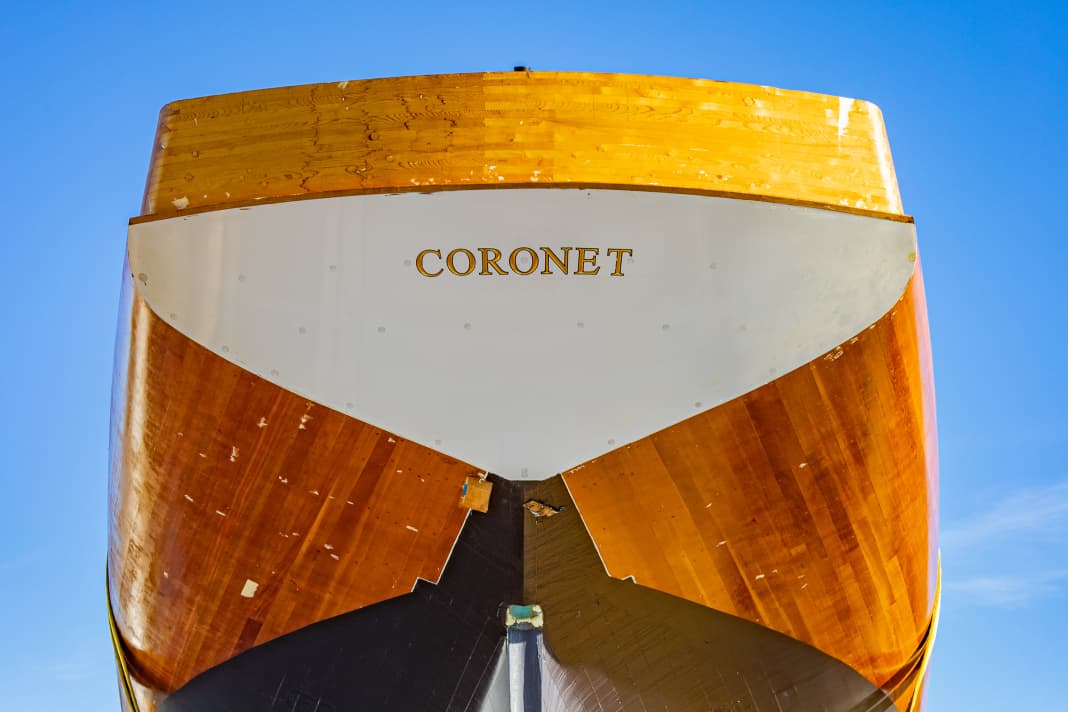"Coronet": After 27 years of refit, the legendary US schooner from 1885 is afloat again
Jochen Rieker
· 07.12.2022






Last Friday, the time had finally come: "Coronet", perhaps the last of the unfinished among the once pioneering classics, touched the water again. After almost three decades on dry land and tens of thousands of hours of boatbuilding finesse, the schooner was lifted into its element by a 1000-tonne floating crane in Newport on the US East Coast.
Most of the deck details, fittings, rigging, sails and the entire interior are still missing. The double-planked hull is only primed above water, not painted black as before. It would therefore be too early to proclaim its completion. But an essential, the most important part of the restoration has now been completed.
The boat, gigantic even by today's superyacht standards, was brought by tugboat to Mystic Seaport, less than 40 miles to the west. The transfer to the Henry B. du Pont Preservation Shipyard - the shipyard that is to complete the project by 2025 - took eight hours. That will be the 140th anniversary of "Coronet's" first launch.
However, one should be careful with forecasts for the future. Deadlines for completion have been set far too often - and then broken. This was already the case in 1995, when the project was announced by Liz Meyer - the same Liz Meyer who helped trigger the boom in large classic refits with the J-Class "Endeavour". And in 2006, when a new investor stepped in.
Back then, YACHT classic flew to the USA especially to document the new start of the extremely complex refit. Regular photographer Nico Krauss captured the status of the preparatory work in impressive pictures. Here is a gallery of the most memorable motifs and text excerpts from the report in YACHT classic 1-2007, which illustrate the dimensions and historical significance of the project:






Excerpts from YACHT classic 1-2007 about the start of the restoration of "Coronet"
The woodwork cracks. Hardly a minute goes by without the acoustic reminder that this was once a very lively organism. But it is not the massive oak frames, similar in size to the planks of a railway track, that make the noise. Nor the planks, nor the keelson, nor the beams, nor the entire, seemingly endless deck measuring an incredible 40 metres. Not a sound comes from them. "Coronet" lies still like a beached whale.
She no longer works. Not for a long time.
What was once one of the proudest schooners of the Victorian era in boat building has been resting here on the waterfront of Narragansett Bay in Newport for 13 years. An epitome of a belief in progress, cosmopolitanism and a desire for representation. Not just some spawn of the American dream - a queen.
Little remains of Coronet's splendour. The colossal hull has developed deep cracks. It no longer stretches, it bulges and sags.
The dryness of his last storage place has left him completely scarred, even more so than the neglect of the many decades he spent in the service of a mission church.
Since "Coronet" was lifted by a travel lift in the fashionable New England coastal town at 10 a.m. on 22 April 1995, it has not touched water for 13 long years. In front of Thames Street, where there used to be a pretty park, a hall has been built for her: hollow like a house of cards, five storeys high, roof and walls made of semi-transparent polyester profiles.
When the sun shines on it, it is the expansion of the plastic that breaks the otherwise tomb-like silence with a loud crack. Sometimes, the sounds of wind and rain also rumble through the modern mausoleum. But "Coronet" itself lies there as if dead.
But it is only a deep sleep. In a few weeks, finally, the 26-year-long attempt to restore her to her former glory at sea under 772 square metres of canvas will begin in earnest.
It is set to be the most complex refit project in recent times, perhaps the largest ever.
Robert McNeil, a venture capitalist from San Francisco who is as wealthy as he is boat-loving, signed an agreement in December last year that guarantees the restoration "to the highest historical standards". Exactly in the style and technology of the late 19th century from which it originated. That's probably how it will turn out. McNeil is a man of principle. "Walk your talk", he says, let your words be followed by deeds.
He has already made a name for himself with other prestigious restorations: with "Joyant", he owns an R-class yacht designed by Herreshoff in top condition. Most recently, a team he put together reconstructed "Cangarda", one of the last remaining steam yachts with a clipper bow in the USA. Ambitious, highly acclaimed work.
And yet there is no comparison with "Coronet". The schooner's size alone makes it an extraordinary project.
Anyone who steps through the door of the warehouse in Newport and sees the enormous bow towering almost vertically in front of them is literally overwhelmed by a feeling of awe.
Built in 1885, this yacht, operated purely for private pleasure, looks like a monument. An oil painting from the early days shows her under full sail, flying lightly over choppy seas, elegant and dynamic. Only in real life, on dry land, do you realise her colossal appearance.
Below deck, the effect is almost more immediate. Workers have removed planks between two frames in the keel area. One of the many wounds inflicted on "Coronet" in order to save her. Bob McNeil's boat builders enter the ship via the gap when they are on site preparing for the refit. The way around to the aft deck, seven metres higher, and then three metres back down the companionway would take much longer.
Inside, the men are greeted by the same damp, musty odour. And a view that hardly anyone will ever get used to: Along the entire length and across the full width of the boat, no bulkhead or frame frame frame limits the perspective. Just space, space, space over 40 by 8.20 metres.
What was once bolted, riveted and mortised there, the entire interior of this gigantic dance hall, is the other reason why "Coronet" is considered "America's most historic yacht", as Susan Daly says. As director of the International Yacht Restoration School, she has tracked and documented the preservation of the substance. She keeps folders full of inventory lists in her office not far from the boat storage area.
It contains photos, measurements and descriptions of thousands (!) of objects that were secured during the gutting of the schooner: from the fold-out porcelain washbasin and football-sized blocks of ash wood to the artistically crafted stained glass windows of the saloon doors.
The quantity of these original fixtures and fittings fills a warehouse of its own. An evidence room of rare treasures. They already make "Coronet" unique.
The white Hulk, once painted black, fits like a key in the lock to the early yacht-building history of the "Gilded Age", the heyday of the US economy after the Civil War. "Perhaps the most remarkable thing about her is that she still exists at all," says Susan Daly.
A large part of the hull restoration can be on this homepage of the IYRS crew, including numerous photos.
The new owners of "Coronet", the founders and partners of "Crew" in New York, have given the boat a new lease of life. a new Internet presence. There you will find historical documents as well as current pictures of the launching and transfer and, in future, of further work in Mystic Seaport.

